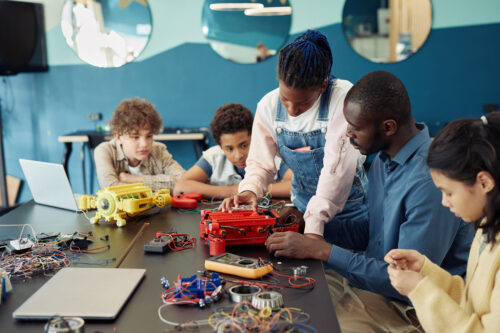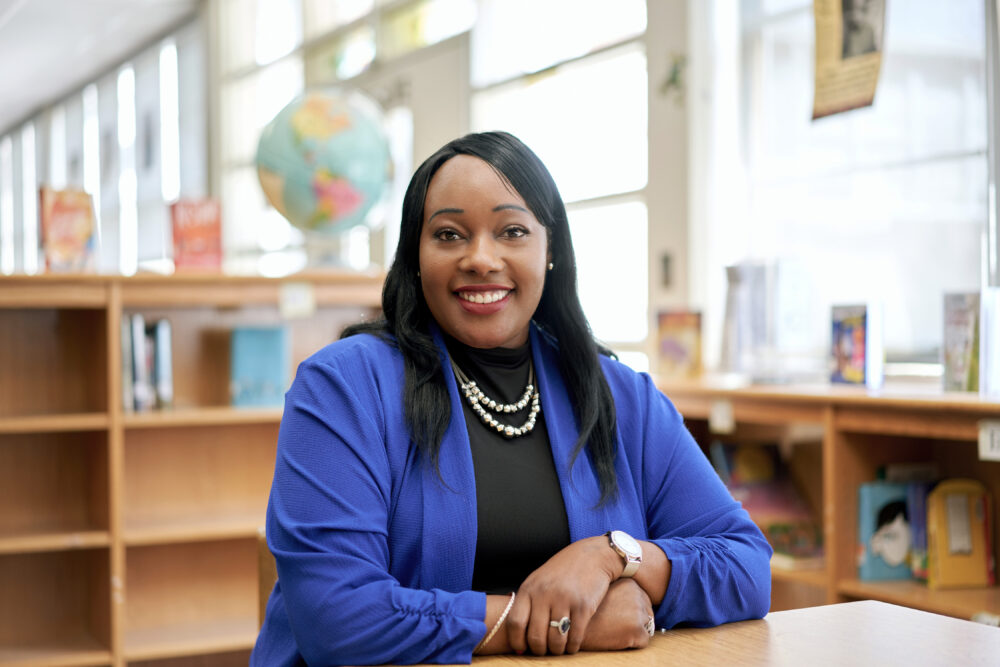
Imagine a classroom where every student feels seen, heard, empowered, and respected for bringing their full self to the learning experience. How can educators create such a supportive environment?
At UnboundEd, we empower educators to meet the needs of every single student through grade-level, engaging, affirming, and meaningful — GLEAM® — instruction so all students succeed academically. By affirming, we mean honoring all students and their varied experiences and backgrounds in the context of grade-level learning, creating a space where students feel safe, supported, and immersed in their learning. Each student has many interwoven facets that shape who they are, including their background, language, lived experiences, and personal interests. Affirming environments help students recognize and build on these facets, creating a beautiful and complete picture of who they are.
Affirming environments are crucial for student engagement and well-being. When students feel that adults respect and value them, they become more engaged and motivated (Mangino, 2023). Such environments improve academic outcomes, foster belonging (Gray, 2021, as cited in Bowen, 2021), and help dismantle barriers to effective instruction.
By valuing and elevating the abilities of all students, educators create safe and supportive classrooms where students can thrive, enhancing their self-esteem and academic performance (Learning Policy Institute, 2019). By integrating affirming instructional practices and interactions, educators can ensure that every student feels seen, heard, respected, valued, and supported in all aspects of their educational experience.
Creating Affirming Learning Environments
To create an affirming environment where all students can thrive, educators must focus on three key elements:
- Honoring students’ whole identities
- Cultivating those identities
- Fostering interpersonal connections, trust, and support.
Let’s explore how each characteristic converges and contributes to building an affirming and empowering educational experience.
Honor Students’ Whole Identities
Creating an affirming environment begins with recognizing and valuing aspects of each student’s identity, including their cultural, linguistic, and academic backgrounds. This recognition is about actively honoring, including, and leveraging these identities in the classroom, ensuring that every student feels seen and validated. An affirming environment is a daily reminder to each student that they matter. Such recognition fosters a sense of belonging, enhances student engagement and motivation, and lays a strong foundation for academic success.
Integrating students’ backgrounds into the curriculum is a powerful way to honor their identities.
For example, in an English Language Arts classroom, educators can offer students a choice in texts, assignments, or products based on their interests. This approach allows students to see themselves in the materials they engage with and promotes agency, making learning more relevant and purposeful. Additionally, embedding students’ home languages into teaching and learning activities through writing or discussion alongside English can further validate their identities, encourage self-expression, and enhance their understanding and connection to the content.
Cultivate Students’ Identities
Cultivating students’ identities involves actively helping them explore, understand, and develop their own identities. This process supports their growth into confident and self-assured individuals. Affirmation is not just about being seen — it’s about students seeing themselves in new ways and realizing their potential.
Cultivating students’ identities involves guiding them in self-exploration and encouraging self-expression. This process helps students articulate their unique perspectives. It helps them understand how their experiences shape their views — fostering self-awareness and ownership of their learning journey.
Intentionally helping students develop their scientific identities is vital.
Educators can achieve this by helping students see the science in their everyday experiences. For example, in a high school science classroom, a teacher asks a student to share his experiences monitoring and adjusting pH levels in his aquarium. This sharing sparks a class discussion on the delicate balance required for aquatic life. The teacher guides the conversation on the importance of water quality for all forms of life. He then uses this discussion to create relevance for the new unit, where students will study the biotic and abiotic factors contributing to acidity levels. But just as importantly, he helps the student with the aquarium see himself as a scientist — a valid and valuable doer of science. This opportunity to share interests and identity helps students develop stronger senses of self and purpose.
Encouraging self-awareness through reflection and discussion deepens students’ connection to the material and promotes critical thinking. Viewing their learning through the lens of their experiences empowers students to express themselves fully and pursue their academic and personal goals with confidence.
Foster Interpersonal Connections, Trust, and Support
As Rita Pierson said, “Kids don’t learn from people they don’t like” (Pierson, 2013). We often overlook this simple concept. Trust and connection aren’t just nice-to-haves. They are essential for affirming interactions and impactful learning. They create a foundation where students feel secure, respected, and open to engaging deeply with the learning. Authentic connections and trust allow students to feel respected and understood, which makes them more open to learning. Building trust goes beyond superficial connections. It involves making deep, personal connections with students.
Educators can achieve this by truly understanding each student’s interests and background and thoughtfully incorporating these insights into lessons or daily interactions.
For example, in a fourth-grade math class, the teacher notices a usually engaged student becoming withdrawn during a lesson on fractions. Sensing something is wrong, the teacher privately asks the student about their feelings and learns the student is struggling and feels embarrassed about not grasping the concept quickly. The teacher shares their own experiences of struggling with math and reassures the student that it’s okay to need extra support. The teacher asks the student to bring in a favorite family recipe for homework. In the next lesson, the teacher demonstrates how students can use the quarter and half cups to achieve equivalent amounts in the recipe. She then allows the student and some friends to use a set of measuring cups and flour to illustrate the lesson problems and determine if the two fractions with different denominators are equivalent. This honest conversation and connection to student interest builds psychological safety and trust, helping students feel secure, respected, and more willing to engage in class.
Moving Forward with Purpose
Affirming environments are essential for fostering student engagement, well-being, and academic success.
To cultivate an affirming environment, consider adopting these key mindsets and practices:
- Honor and use students’ identities and lived experiences in teaching and learning.
- Provide opportunities for students to explore and express who they are, both personally and academically.
- Build authentic relationships with students that go beyond the superficial.
As educators, it’s crucial to adopt these practices. It’s also important to advocate for them in our schools and communities. Only then will we have affirming environments where students recognize their brilliance, feel empowered in their identity, and are prepared to impact the world.
Whether you lead a classroom or a school system, you’re on a journey toward better, more equitable learning for your students. At UnboundEd, we’re here to partner with you every step of the way, offering proven tools and programs tailored to your specific needs.
Be sure to check out the blogs below to learn more about the other elements of GLEAM instruction.
Read About the Elements of GLEAM Instruction


Engaging Instruction: Designing Student-Centered Learning Experiences

Meaningful Instruction: Fostering Critical Thinking, Advocacy, and Change in the Classroom
References
Bowen, J. (2021, October 21). Why is it important for students to feel a sense of belonging at school? Students choose to be in environments that make them feel a sense of fit, says Associate Professor DeLeon Gray. NC State College of Education. Retrieved from https://ced.ncsu.edu/news/2021/10/21/why-is-it-important-for-students-to-feel-a-sense-of-belonging-at-school-students-choose-to-be-in-environments-that-make-them-feel-a-sense-of-fit-says-associate-professor-deleon-gra/
Learning Policy Institute. (2019). Restorative approaches to building equitable school environments. https://learningpolicyinstitute.org/media/492/download?inline&file=WCE_Restorative%20Approach_Equitable_Education_BRIEF.pdf
Mangino, M. (2023, February 16). Why a sense of belonging matters. https://tll.mit.edu/sense-of-belonging-matters/
Pierson, R. (2013, May). Every kid needs a champion [Video]. TED Conferences. https://www.ted.com/talks/rita_pierson_every_kid_needs_a_champion?subtitle=en
